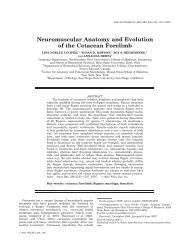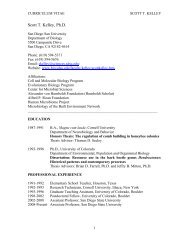Comparative anatomy and evolution of the odontocete forelimb
Comparative anatomy and evolution of the odontocete forelimb
Comparative anatomy and evolution of the odontocete forelimb
Create successful ePaper yourself
Turn your PDF publications into a flip-book with our unique Google optimized e-Paper software.
8 MARINE MAMMAL SCIENCE, VOL. **, NO. **, 2009<br />
with <strong>the</strong> coracoid process. Thus, species with a wide coracoid process, such as G.<br />
griseus, also exhibited a wider origin than insertion <strong>of</strong> this muscle. In contrast,<br />
species with a small or narrow coracoid process, such as K. simus, presented a narrow<br />
insertion with <strong>the</strong> same width as in <strong>the</strong> origin. C. commersonii, Phocoenoides dalli, K.<br />
simus, <strong>and</strong> P. phocoena display a coracobrachialis muscle that is narrow at <strong>the</strong> origin <strong>and</strong><br />
remains relatively <strong>the</strong> same width until it reaches <strong>the</strong> site <strong>of</strong> insertion. The thickest<br />
coracobrachialis muscle was found in T. truncatus; followed by D. capensis, which was<br />
also bulbous in shape. The two phocoenids, <strong>and</strong> C. commersonii displayed <strong>the</strong> flattest<br />
muscle. G. griseus was unique, exhibiting a muscle possessing a thick muscle belly<br />
at <strong>the</strong> origin with fibers that became thinner as <strong>the</strong>y come toge<strong>the</strong>r at <strong>the</strong> site <strong>of</strong><br />
insertion. K. simus displayed <strong>the</strong> narrowest muscle <strong>of</strong> all <strong>odontocete</strong>s investigated.<br />
Deltoid—This is a convergent muscle in which <strong>the</strong> main difference among all<br />
species studied was <strong>the</strong> scapular area covered by <strong>the</strong> muscle <strong>and</strong> <strong>the</strong> size <strong>of</strong> <strong>the</strong> muscle<br />
belly. In most species it covers one-half <strong>of</strong> <strong>the</strong> antero-lateral side <strong>of</strong> <strong>the</strong> scapula;<br />
<strong>the</strong> exceptions were <strong>the</strong> dwarf sperm whale <strong>and</strong> Risso’s dolphin. In K. simus, this<br />
muscle covers only one-third <strong>of</strong> <strong>the</strong> scapula <strong>and</strong> in G. griseus it covered slightly<br />
more than one-third <strong>of</strong> <strong>the</strong> scapula. An interesting case is K. simus, in which this<br />
muscle follows <strong>the</strong> antero-vertebral curvature formed by <strong>the</strong> acromion process <strong>and</strong><br />
<strong>the</strong> scapula blade; giving it a very irregular shape. The two phocoenids presented<br />
<strong>the</strong> thinnest muscle belly <strong>of</strong> all <strong>the</strong> species dissected, compared to T. truncatus that<br />
possessed <strong>the</strong> thickest one. Cooper (2004) also found this muscle to be bisected<br />
postero-anteriorly by a connective tissue sheet in <strong>the</strong> ziphiid, Ziphius cavirostris, thus<br />
making it a multipennate muscle. However this observation was not confirmed in<br />
any <strong>of</strong> <strong>the</strong> <strong>odontocete</strong>s in this study.<br />
Supraspinatus—This is a convergent muscle that completely covers <strong>the</strong> area between<br />
<strong>the</strong> acromion <strong>and</strong> <strong>the</strong> coracoid process <strong>of</strong> <strong>the</strong> scapula. All <strong>odontocete</strong> species dissected<br />
exhibited a supraspinous muscle with fascicles that increased in breadth as <strong>the</strong>y extend<br />
from <strong>the</strong> vertebral border toward <strong>the</strong> brachial region <strong>and</strong> <strong>the</strong>n become narrow as <strong>the</strong>y<br />
come toge<strong>the</strong>r at <strong>the</strong> site <strong>of</strong> insertion. The widest point is <strong>the</strong> part <strong>of</strong> this muscle<br />
that passed through <strong>the</strong> acromion <strong>and</strong> coracoid processes. Thus, this muscle also<br />
showed a direct relationship with <strong>the</strong> acromion <strong>and</strong> coracoid processes. The thickest<br />
<strong>and</strong> largest tendon <strong>of</strong> insertion was found in one D. capensis specimen; though <strong>the</strong><br />
second specimen <strong>and</strong> <strong>the</strong> remaining species dissected had a very short tendon or<br />
attached directly into <strong>the</strong> bone.<br />
Infraspinatus—This muscle is located posterior to <strong>the</strong> deltoid, anterior to <strong>the</strong> teres<br />
major <strong>and</strong> below <strong>the</strong> scapular spine. The main distinction was seen in <strong>the</strong> three<br />
different areas covered by this muscle. The species C. commersonii, D. capensis, T.<br />
truncatus, <strong>and</strong> P. phocoena, possessed an infraspinatus muscle that covered one-fourth<br />
<strong>of</strong> <strong>the</strong> lateral surface <strong>of</strong> <strong>the</strong> scapula. G. griseus <strong>and</strong> P. dalli displayed a larger muscle<br />
that occupied one-third <strong>of</strong> <strong>the</strong> scapular surface. The physeterid, K. simus, was unique<br />
in that this muscle exp<strong>and</strong>ed through out most <strong>of</strong> <strong>the</strong> posterior half <strong>of</strong> <strong>the</strong> scapular<br />
surface, occupying almost one-half <strong>of</strong> <strong>the</strong> scapular blade <strong>and</strong> leaving very little space<br />
for <strong>the</strong> origin <strong>of</strong> <strong>the</strong> teres major muscle.<br />
Teres major—This is a convergent muscle found on <strong>the</strong> posterior lateral side <strong>of</strong><br />
<strong>the</strong> scapula, next to <strong>the</strong> infraspinatus, with some fascicles extending to <strong>the</strong> medial<br />
side, adjacent to <strong>the</strong> subscapularis muscle. In <strong>odontocete</strong>s, this muscle varied only<br />
in <strong>the</strong> amount <strong>of</strong> scapular area covered. Some species, such as C. commersonii, D.<br />
capensis, T. truncatus, G. griseus, <strong>and</strong> P. phocoena, possessed a teres major that extends<br />
through one-fourth <strong>of</strong> <strong>the</strong> scapular surface. O<strong>the</strong>r species (i.e., P. dalli), had a smaller<br />
muscle covering only one-fifth <strong>of</strong> <strong>the</strong> scapular blade. K. simus exhibited a teres major




